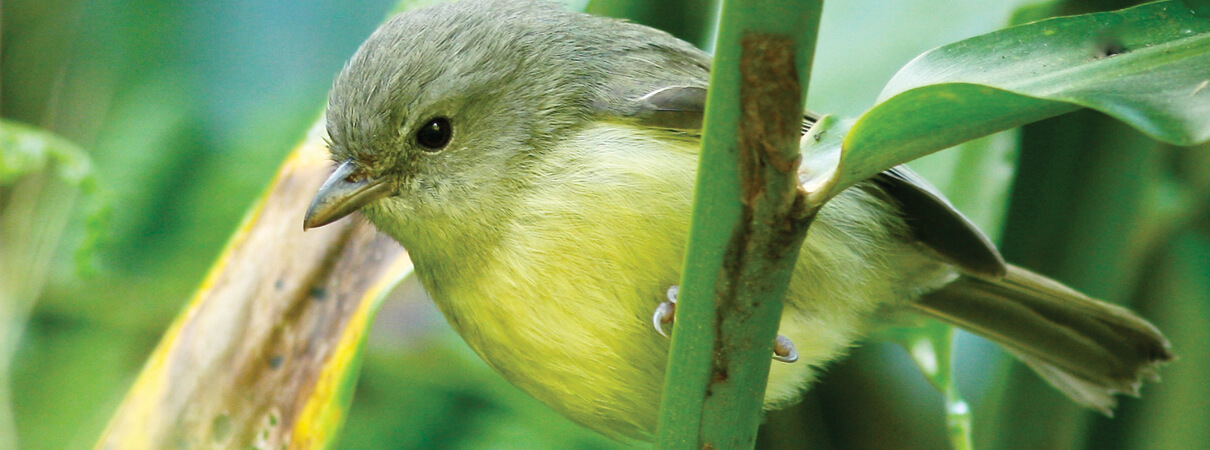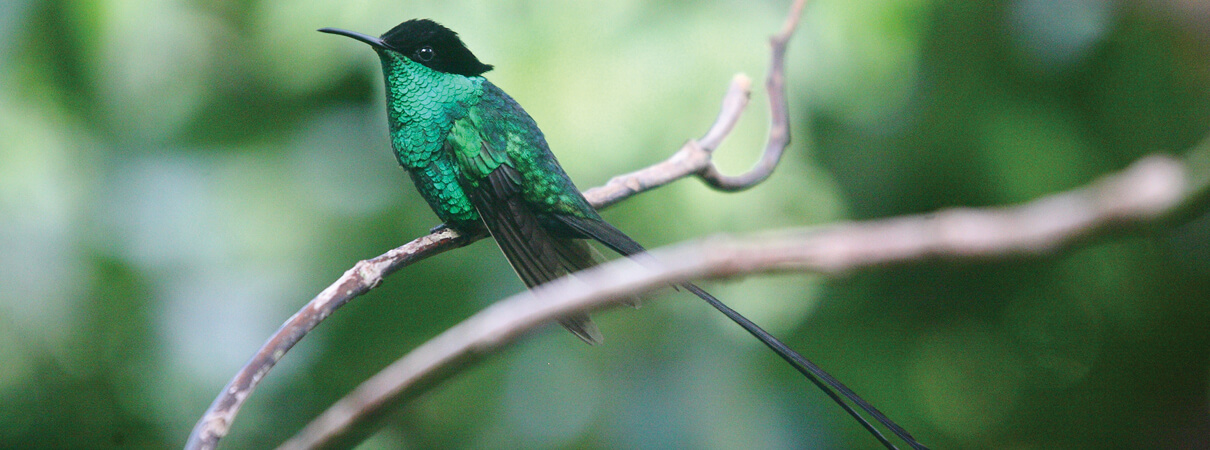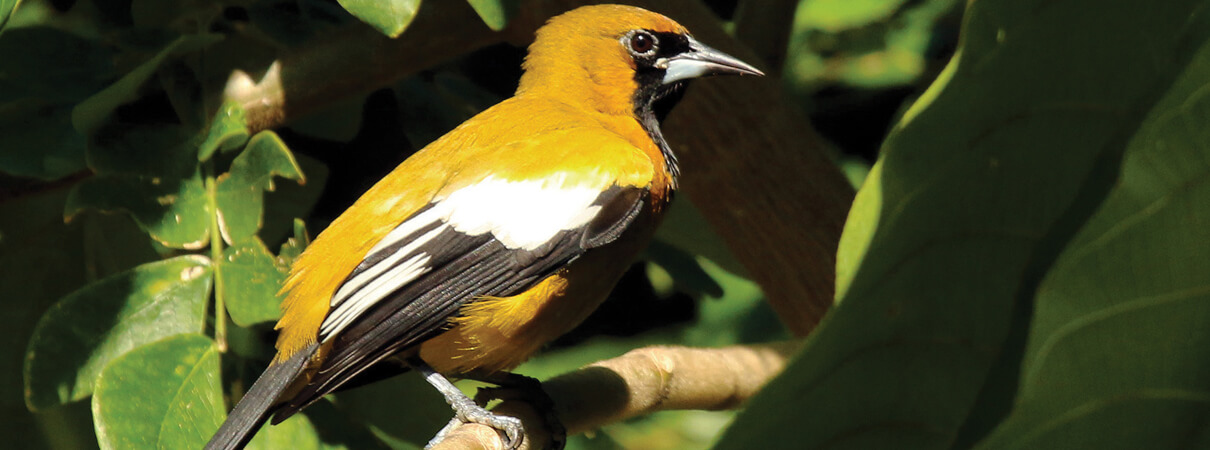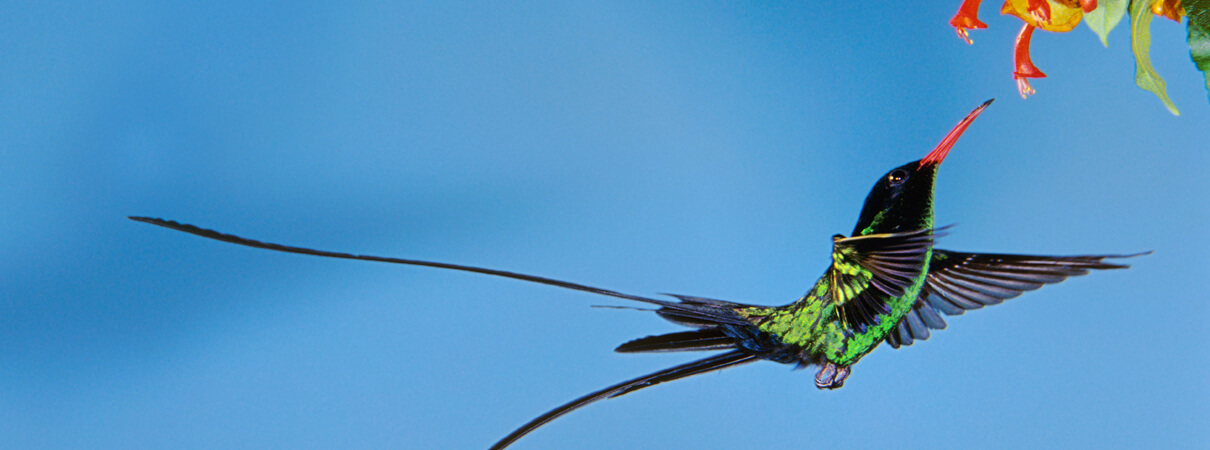Meet the Streamertail, the 'Most Beautiful Bird in Jamaica'
Jamaica is a naturalist's dream, with a remarkably high proportion of plants and animals that occur nowhere else on the planet. Among its 28 endemic bird species are the Red-billed Streamertail, which is the most abundant and widespread hummingbird in Jamaica, and the Black-billed Streamertail, a far less common hummingbird found only in the eastern part of the island.

Red-billed Streamertail by Alfred Yan
The two species are sometimes lumped together as one—the Streamertail—including when it was chosen as the national bird of Jamaica.
Thanks to a new partnership between American Bird Conservancy and the Jamaica Conservation and Development Trust, work is now under way to enhance opportunities for bird conservation to benefit the Streamertail and many other birds in one of the country's most remarkable protected areas: the Blue and John Crow Mountains National Park.
ABC recently helped the Trust win a grant from the Latin American Reserve Stewardship Initiative (a partnership of the March Conservation Fund and ABC) to develop a much-needed tourism strategy.

Blue Mountain Vireo, one of the bird species found only in Jamaica. Photo by Paul B. Jones
This grant aims to increase visitation and revenue to the park to strengthen park management and conservation, and to benefit the Streamertail and other Jamaican endemics such as the Jamaican Blackbird, Yellow-billed Parrot, Crested Quail-Dove, and Blue Mountain Vireo.
Neotropical migrants that find stopover and wintering habitat in the park will also likely benefit, including Ovenbird, Black-throated Blue Warbler, and Prairie Warbler. American Redstart, and Black-and-white Warbler are other migratory birds found in the park.
Streamertail or 'Doctor Bird'?
The local name for the Streamertail is “doctor bird.” The male's outer tail feathers, which are longer than the bird itself, along with its black crest, reminded Jamaicans of the top hat and coattails of an old-time doctor. The Arawak Indians, who were early inhabitants on the island, referred to the Streamertail as the “God bird,” since they believed these hummingbirds had magical powers and were the reincarnation of dead souls.
This snazzy hummingbird has also caught the eye of visitors. In Ian Fleming's James Bond short story, For Your Eyes Only, the first line reads, “The most beautiful bird in Jamaica, and some say the most beautiful bird in the world, is the streamer-tail or doctor humming-bird.”

Black-billed Streamertail courtesy of Blue and John Crow Mountains National Park
These eye-catching hummingbirds are the only two members of the genus Trochilus, which is endemic to Jamaica. The genus is currently split into two separate species, the Red-billed and Black-billed Streamertail.
The males grow remarkable specialized tail feathers, called “streamers,” which have scalloped and fluted edges that make high whining sounds as the bird buzzes around. Males wave these long tail streamers to entice females, but outside of breeding, the species are solitary, like most other hummingbirds.
The Red-billed can be found in a wide variety of Jamaican habitats from sea level to the highest mountains. They are most abundant in closed forests, but also visit plantations, parks, and gardens with suitable flowers and hummingbird feeders.
The Black-billed occurs only in eastern Jamaica, particularly in the humid reaches of the John Crow Mountains. Its range overlaps with the Red-billed Streamertail's between the Blue and John Crow ranges, where these two species often interbreed.
“Jamaica is home to such a remarkable diversity of birds,” says John Tschirky, an International Program Officer with ABC. “By supporting the Trust's efforts to enhance the management of this important Caribbean landscape, we are taking a key step toward protecting their birds.”
A Park of Many Parts
Situated in the northeastern part of the island near Jamaica's capital, Kingston, the Blue and John Crow Mountains National Park protects 120,000 acres of moist tropical and subtropical forest. It is one of the largest protected areas in the Caribbean and also one of the region's largest migratory bird hotspots.

Cloud forest in the national park by Susan Otuokon, Jamaica Conservation and Development Trust
Two main mountain ranges have their own distinctive characteristics. The Blue Mountains reach 28 miles across the eastern part of Jamaica and are frequently covered in mist, giving them a characteristic blue color.
These are Jamaica's highest mountains; they rise steeply in such a small area that it is possible to drive in a few hours from the coastal plains to an elevation of more than 7,000 feet. The Blue Mountains are famous for their coffee plantations, where the highly sought-after Blue Mountain coffee is produced.
The John Crow range parallels the northeast coast. Although the geology of the Blue Mountains is shale, the John Crow Mountains are limestone, so the soil and vegetation, as well as flora and fauna, are different. The name “John Crow” comes from the Jamaican name for the Turkey Vulture, a common bird in the area. At its southernmost point, this range joins the eastern end of the Blue Mountains.
Mountains For All
When Columbus encountered Jamaica in 1494, these mountains were heavily forested. Early Spanish settlers established cattle ranches at the foot of the mountains; when the English captured the island, they cleared the lower slopes for farming and logged the forests.
Today, the upper reaches of the park's mountains remain protected, closed-canopy moist tropical forest. The rest of the park consists of buffer and recovery zones made up of modified forest, timber plantations, shade coffee groves, and degraded woodlands.

Jamaican Oriole, one of the island's many endemics by Sharp Photography
It's the Trust's job to manage the park on behalf of one government agency; the group also coordinates with other organizations that play a role, including the Forestry Department, cultural heritage preservation agencies, and community-based organizations. Their job is a big one, involving work with surrounding communities to promote sustainable livelihoods and stewardship of the area's natural and cultural resources.
But it's a job that is abundantly worthwhile for all concerned. The park's core Preservation Zone, roughly 65,000 acres, is recognized as a UNESCO World Heritage Site for both its biological and cultural value. In addition to its high level of endemic species, it has an important place in Jamaica's history as a refuge for slaves seeking freedom from colonial plantations.
The park's mountainous slopes also comprise an important watershed, supplying water to over 40 percent of the island's population.
“Jamaica is going through severe drought right now, and water rationing has been put in place,” Tschirky says. “Protected and well-managed watersheds are needed more than ever, for the people and for the future of plants and animals found nowhere else.”

Red-billed Streamertail by Rolf Nussbaumer Photography/Alamy Stock Photo
If you plan a visit, be sure to visit the 30-acre Holywell area. “This ‘park within a park' serves as a gateway,” says Susan Otuokon, the Trust's Executive Director. “Holywell features five wonderful trails and a very interesting visitor's center, along with interpretive signage in the picnic areas and on trails.”
It's also where you'll pay your entrance fee to the Blue and John Crow Mountains National Park, contributing to protection of the Streamertail—and all of this Jamaican wonderland.
Editor's note: This article first appeared in the summer 2016 edition of Bird Conservation magazine. The magazine is a member benefit; to receive it, join today!
Gemma Radko is ABC's Communications and Media Manager. She graduated from Allegheny College with degrees in Art and Biology and has over 20 years of graphic design, writing, and editing experience. Gemma is an avid birder and is a member of both the Montgomery and Frederick chapters of the Maryland Ornithological Society, often leading field trips for members. A licensed bird bander, she has in the past run a MAPS (Monitoring Avian Productivity and Survivorship) station.


















































